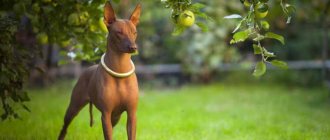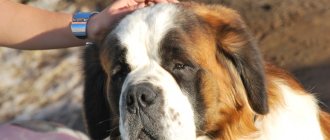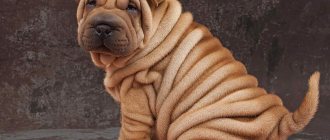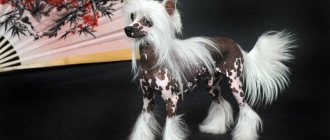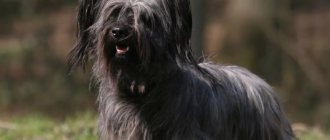History of the breed
The first dog of the St. Petersburg Orchid breed appeared in 1997 during the selection work of Nina Petrovna Nasibova. The breeder worked towards her goal of developing a new decorative breed of dogs for several years. The orchids are based on several popular miniature dog breeds, including: Chihuahua, Toy Poodle, Lapdog, Yorkshire Terrier.
The St. Petersburg orchid did not get its name by chance. The discovery of the breed was timed to coincide with the anniversary of St. Petersburg (300 years). Attractive, charming, good-natured kids became a kind of gift from N.P. Nasibova.
Petersburg miniature dog
According to the woman, the first half of the name was born immediately, but the breeder had doubts about the second, choosing between an orchid and a butterfly. Ultimately, after observing the puppies of various colors and long hair flowing in waves, Nina Petrovna chose a flower name.
Before the painstaking work of breeding the domestic toy dog, Nina Nasibova participated in the selection of other new breeds, and was also involved in breeding Russian toy terriers.
After breeding and consolidating the standards of the St. Petersburg orchid, Nina Petrovna received a breeding patent, guaranteeing her sole control over the breeding of this breed for 30 years.
The young dog breed has not yet been recognized by the RKF (Russian Canine Federation), but it already has numerous fans captivated by the character and unusual appearance of orchids. There is a club of the same name, headed by N.P. Nasibova and engaged in breeding the “Petersburg Orchid”.
Features of mating dogs of the St. Petersburg Orchid breed
Breeding purebred dogs must be approached with all responsibility. It is worth paying attention to what breed characteristics are transmitted so that there is no degeneration. It is also necessary to take into account the fact that the Neva Orchid is a fairly young dog breed, and its population is not large. It is not advisable to engage in breeding yourself; it is better to entrust this to a specialist. This dog has its own club, which is called “Petersburg Orchid”. Control over the offspring is exercised by the creator of the breed herself.
For your information! A litter can produce 5-7 puppies.
Description and breed standard
The St. Petersburg Orchid breed gives dogs an original look: bangs, long ears, flowing fur, beady eyes - a real fashionista. Representatives of the breed are miniature, agile dogs, elongated in size, medium boned and lean muscle mass.
For reference: It is interesting that orchids exhibit sexual dimorphism associated with appearance and behavior.
- It's not me…
The breed standard is at the approval stage.
| Head | Medium size, rectangular, dry, light. The muzzle is pointed towards the end, making up a third of the body length. Pronounced, but not sharp transition from forehead to muzzle. The nose is small in size and can be either black or colored to match the color of the coat. |
| Height | No more than 30 centimeters |
| Weight | No more than 4 kilograms. The bitch should not weigh less than one and a half kg, otherwise independent whelping is impossible. |
| Eyes | Set wide apart, oval in shape, small. The look is meaningful. The color is dark. |
| Ears | The average size. They hang on cartilages, are located high, rounded. |
| Jaws | Small, sharp teeth, correct bite. |
| Neck | The bend is smooth, dry, elongated. |
| Torso | Stretching index 106-108. The back is straight, wide, muscular. The withers are well expressed. The loin is muscular, slightly convex. The croup angle is 15-30 degrees. The stomach is taut. The chest is deep. |
| Limbs | Dry, small, oval, located parallel to each other. |
| Tail | Located below the back line. Short cupping is possible (2 vertebrae). The undocked ponytail is curled in a ring. |
Color and coat
The babies' fur is long, thick and slightly wavy. There are different colors, except white. There are multi-colored and monochromatic individuals; some dogs have a mask on their muzzle. The most colorful orchids with fur are brindle, black, murugi and black and tan. Tan marks can be of various shades: red, gray, cognac, yellow and others.
Chocolate color
In addition, the animal’s fur can be of the following shades:
- red;
- chocolate;
- silver or blue;
- ginger.
Therefore, it is impossible to meet two identical dogs. Nina Nasibova continues her breeding work and now her goal is to obtain dogs with spotted coats.
For reference: It is interesting that there are two types of animals: with short and long hair. The short-haired ones are called “Neva Orchid”.
Breed characteristics and character traits
Dogs of the St. Petersburg Orchid breed are distinguished by their intelligence, intelligence, and unobtrusive friendliness. They are affectionate and gentle, so they need a warm response. Owners of babies claim that during times of blues and bad mood there is nothing better than communicating with a pet.
Animals are devoid of aggression, they joyfully greet guests, willingly meet strangers, play with children and other animals. Although the pet is happy to be in the spotlight, it will not get in the way. Therefore, the St. Petersburg Orchid is a dog that will become an excellent companion for a person of any age.
Important! For people suffering from allergies, orchids are a godsend. Dogs are not subject to shedding and do not smell like dogs.
Dogs behave calmly in their arms during walks or at a party. The only problem is the dog’s physique, which, due to carelessness, can be injured by the owner himself.
Similar breeds by height and weight
Australian dingo
Australian dingo is an Australian breed...
Prague rat
Prague Ratlik, Ratlik (international…
German Spitz
The German Spitz is a German breed with...
Mexican Hairless Dog (Xoloitzcuintle)
Mexican Hairless Dog or Xol…
English miniature spitz
The English Miniature Spitz is a breed...
Care and maintenance
St. Petersburg orchids are not demanding to care for.
- I need to get my hair cut!..
But, it is necessary to accustom them to the toilet and mandatory hygiene procedures:
- hair cutting (every two months) and combing (preferably daily);
- trimming claws (as necessary);
- bathing and blow-drying (at least every 10 days);
- ear cleaning (weekly);
- rubbing the eyes (daily);
- brushing your teeth (weekly);
- cleaning the anal glands (once a quarter).
Advice. It is advisable to visit a veterinarian to remove plaque and monitor your pet's health.
A haircut
Orchids have a signature haircut:
- Fully cut ponytail;
- Uncut bangs on the forehead, beard, mustache, ears with fluffy and long hair;
- The hair on the paws and between the toes is trimmed;
- The hair on the chest and back is removed with a machine;
- The legs are trimmed.
Bathing
A dog should be taught to bathe from an early age. Otherwise, the pole will fade and begin to split.
Advice. To prevent your dog's paws from slipping, it is recommended to bathe him by placing him on a rubberized mat.
If it is not possible to bathe the animal, then you can use dry shampoo, but you should not comb the dirty fur.
A pet
Diseases
Since the breed was bred recently, no specific diseases have been identified. Like other decorative babies, orchids may have problems with teeth, injuries due to fragile bone tissue, in addition, the dog needs to be additionally insulated during walks, especially in winter.
Attention! Improper feeding can lead to inflammation of the paraanal glands. The first signs of the disease: the dog licking the anus, its redness.
Vaccinations
The puppy receives the first vaccination at 8 weeks of age, the next one is given 3 weeks later. Nina Petrovna recommends repeating the vaccination every year. Before vaccination, your four-legged friend must be given a dewormer.
Advice. Deworming must be carried out at least once every six months, regardless of the regularity of walking outside.
Feeding
Your pet's bowls should always have clean water and dry food. The digestion of babies is not designed to accept human food, so it is forbidden to feed dogs food from your table. It is allowed to add fruits and vegetables to the animal’s diet, 15% of the total. As a treat, you can give a piece of cheese or boiled meat.
For reference: Breeders recommend giving dogs a few drops of natural olive oil daily to improve coat quality.
Walk
Miniature dogs are most often litter trained, but it is not wise to deprive little ones of the fresh air. The pet is accustomed to a leash and collar in advance. To do this, the puppies are walked around the house for a few minutes a day. You need to teach the animal that it is controlled by its owner. In potentially dangerous places (transport, pedestrian and underground passages, narrow sidewalks), it is better to pick up your pet.
Walk
For reference: Fresh air is a great way to spend time, improves the functioning of the immune system, provides necessary physical activity, and prevents obesity.
Education and training
A representative of this breed does not require special training. He is quite smart and quickly understands what his owner requires of him.
The most important thing is to accustom him to the tray. To do this you need:
- For the first days at the new place of residence, limit your four-legged friend’s movement around the house, providing him with one room for adaptation;
- Place a bed, bowls of food and a tray;
- It is advisable to take from the breeder a napkin that the puppy used. If the dog goes to the napkin, then he should be encouraged;
- If the baby pees on the floor, then a napkin should be placed in this place;
- If the pet does not understand where to go to the toilet, then you need to poke it with its muzzle into the puddle;
- Once the puppy remembers the napkin, you can move it to the place you want or put it in the tray.
Orchids can be taught simple commands, but most often decorative dogs are not trained.
Character of the breed
In character, the St. Petersburg orchid is as charming as it is in appearance. These small animals are distinguished by their developed intelligence and well understand the emotional states of their owners. The dog is perky and playful, loves to meet people at the door, takes an active part in the life of the family, and offers to play. At the same time, he does not feel sad when alone, he is completely unobtrusive and calm.
The St. Petersburg orchid quickly learns the rules of behavior in the family, understands its place, masters the territory well and correctly uses specially designated areas. The dog is friendly, gets along well with other pets and willingly communicates with guests. He knows how to stand up for himself and behaves nobly.
How much does it cost and how to choose a puppy?
The cost of puppies depends on color, compliance with the breed standard, gender, age and ranges from 15 to 150 thousand rubles.
When purchasing a baby, remember that:
- Only Nina Nasibova and members of the club of the same name have the right to breed the St. Petersburg Orchid breed;
- The puppy must have a mark with the letter T on its hip;
- At 8 weeks, babies receive documents;
- When purchasing, you must enter into an agreement and receive a passport with documents.
Be carefull! Fraudsters, taking advantage of the popularity of the breed, sell mongrel dogs under similar names: “Nevsky Fleur”, “Moscow Orchid” and so on.

